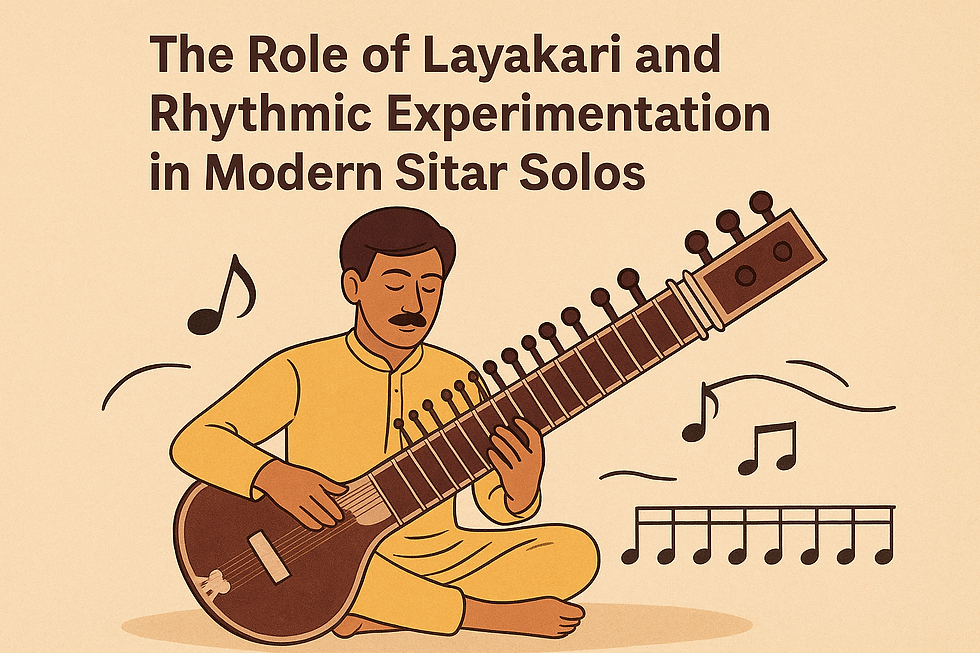"The Art of the Glide: Finding Your Sitar's Voice with Meend"
- Sharanya naidu
- Jul 2
- 4 min read
Updated: Jul 4
For anyone embarking on the journey of learning the Hindustani Sitar, you’ll soon encounter a term of immense significance: Meend. More than just a technique, the meend is the very essence of melodic fluidity, the breath that gives life to a raga, and a hallmark of expressive playing on this beautiful instrument.
So, what exactly is a meend, and how do you achieve it? Let's dive in!

What is Meend?
Simply put, a meend is a smooth, unbroken glide from one note to another, without plucking the string again. Unlike playing individual, distinct notes, a meend creates a continuous sonic arc, allowing you to seamlessly connect pitches and imbue your melodies with emotion and depth. Think of it as a vocal "slide" or a violinist's "portamento."
On the sitar, you primarily execute the meend by pulling the string sideways across the fret while the note is still resonating from an initial pluck. This distinctive technique gives the sitar its characteristic 'singing' quality, allowing it to mimic the nuances of the human voice.
Why is Meend So Important?
Raga Embodiment: Each raga has specific melodic movements and characteristic phrases (pakad). Many of these are defined by how notes connect through meend, rather than just their individual pitches. Without meend, a raga would lose its unique flavor and emotional impact.
Emotional Expression: The subtle variations in the speed and depth of a meend can convey a wide range of emotions—from yearning and melancholy to joy and excitement. It's a powerful tool for storytelling through music.
Mimicking the Voice: Hindustani classical music is deeply rooted in vocal traditions. The meend on the sitar allows it to emulate the delicate glides and inflections of the human voice, making the instrumental music more evocative and human.
Enhancing Resonance: A well-executed meend allows the sound of the previous note to naturally decay into the next, creating a richer, more resonant soundscape.
How to Practice Meend on the Sitar: A Step-by-Step Guide
Learning meend requires patience, precision, and a keen ear. Here's a structured approach:
1. Foundation: Good Plucking and Fretboard Familiarity
Clean Pluck: Before you can glide, you need a clear, sustained initial pluck. Practice hitting the string cleanly with your mizrab (plectrum).
Know Your Frets: Be absolutely sure where your fingers need to land for each note. This will inform how far you need to pull the string for your meend.
2. The Basic Meend: Ascending from a Lower Note
Choose Two Adjacent Notes: Start with a simple meend between two adjacent notes on the same string, for example, from Madhyam (Ma) to Pancham (Pa) on the Gandhar (Ga) string.
Pluck the Lower Note: Pluck the lower note (Ma) with your index finger firmly pressed on the fret.
Pull the String: As the sound of Ma resonates, slowly and steadily pull the string sideways across the fret using the same finger. Your goal is to reach the pitch of Pa without plucking again.
Listen Intently: The most crucial part is to listen carefully. Can you hear the seamless transition? Is there any break in the sound? Is the destination note (Pa) in tune?
3. Increasing the Span: Wider Meends
Once you're comfortable with adjacent notes, try meends spanning two, three, or even more frets. The technique remains the same, but you’ll need to develop more strength and control in your pulling finger.
Example: Try a meend from Re to Ma, or even Sa to Ma, on the lower strings.
4. Descending Meend (Avarohi Meend): More Challenging but Essential
While ascending meends are common, descending meends are also vital. You often achieve these by pulling up from a lower fret to reach the higher note, and then releasing the pull to descend back to the original fret, all in one continuous motion.
This requires even greater control and a subtle release of pressure. Practice slowly and meticulously.
5. Developing Finger Strength and Control:
Daily Practice: Consistent practice is key. Start with short sessions focusing solely on meend.
Strengthening Exercises: Gently squeeze a stress ball or use finger strengtheners to build up hand and finger strength, which is crucial for longer meends.
Relaxation: While strength is important, tension is the enemy of fluidity. Ensure your hand and wrist remain relaxed.
6. Listen, Listen, Listen!
Classical Recordings: Immerse yourself in recordings of master sitarists. Pay close attention to how they employ meend in different ragas and compositions. Notice the subtle variations in their glides.
Your Own Playing: Record yourself and listen back critically. Are your meends smooth? Are they in tune? Where can you improve?
7. Integrating Meend into Melodies:
Once you're comfortable with individual meends, start incorporating them into simple paltas (exercises) and then into the chalan (melodic outline) of a raga.
Don't just play notes; think about how each note connects to the next.
Common Pitfalls to Avoid:
Abrupt Breaks: The most common mistake is a break in the sound during the glide. Ensure your pluck is strong enough and your pull is continuous.
Out-of-Tune Destination: Always check if the final note of your meend is perfectly in tune. Use a tuner or your ear to verify.
Excessive Force: While you need strength, avoid yanking the string aggressively. This can damage your finger and lead to an unpleasant sound.
Lack of Control: Aim for a smooth, controlled glide, not a frantic rush.
Conclusion
The meend is arguably the most expressive technique on the Hindustani Sitar. It's what allows the instrument to sing, to weep, to rejoice. By diligently practicing and truly listening, you'll not only master a crucial technique but also unlock a deeper understanding and appreciation for the nuances of Hindustani classical music. So, pick up your sitar, find your center, and let your fingers begin their beautiful journey of glides. Happy practicing!



Comments